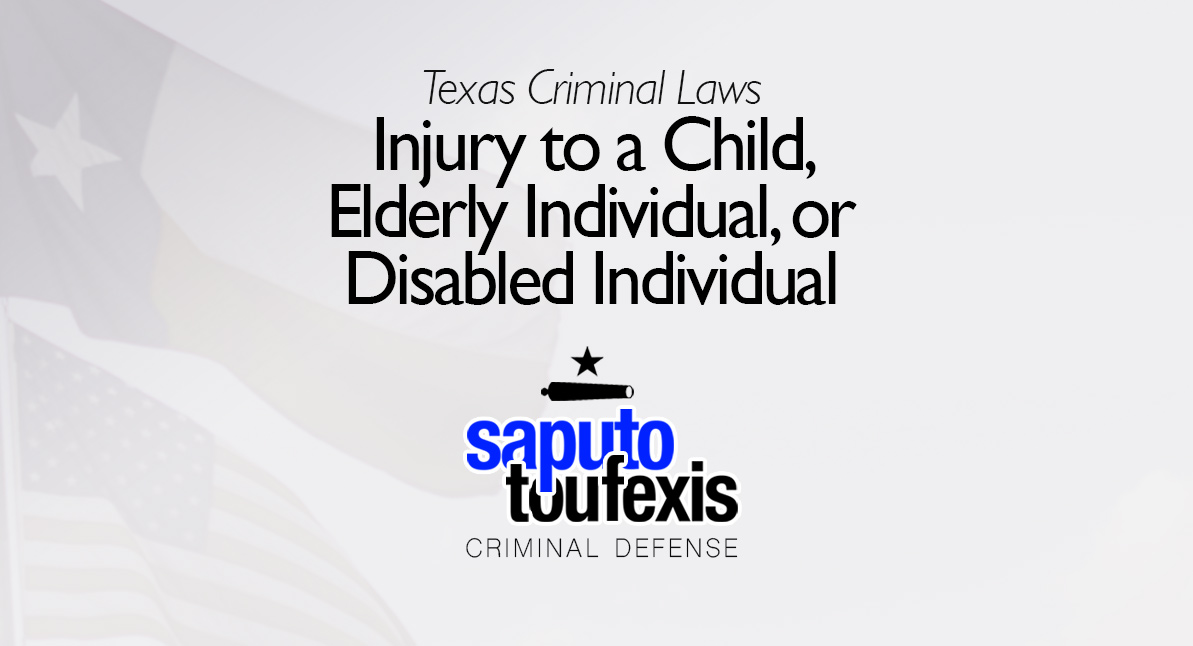The Injury to a Child law actually encompases not just children, but also eldery individuals and disabled individuals. The legislature expanded the offense in 2017 to cover people who operate boarding homes, and the list of disabilities covered now includes people with mental illness.
FAQs about the
Injury to a Child law in Texas
- What is the current Texas law about Injury to a Child, Elderly Individual, or Disabled Individual?
- How old does the child have to be?
- What are the affirmative defenses to Injury to a Child?
- What are other defenses to Injury to a Child?
- Can you be convicted of Injury to a Child for spanking your child?
- What do the state attorneys have to prove?
- What is the statute of limitation for Injury to a Child in Texas?
- What is the penalty for a Texas Injury to a Child offense?
- Can you get probation for Injury to a Child in Texas?
- Do I have to register as a sex offender in Texas if guilty of Injury to a Child?
- What level of crime is Injury to a Child in Texas?
There are four mental states under the Injury to a Child statute that affect how an individual is punished for the crime of Injury to a Child. The four mental states under the Injury to a Child statute are intentionally, knowingly, recklessly, or with criminal negligence.
Have you been charged with Injury to a Child, Elderly Individual, or Disabled Individual? Contact us today to discuss legal representation.
or Text or Call (888) 239-9305
A conviction for intentionally injuring a child will result in a more severe punishment, while a conviction for injuring a child because of criminal negligence will have a less severe punishment. Injury to a Child for failing to act requires a finding that you had a duty to act under the law. There is a duty to act under the Injury to a Child statute if you had been responsible for providing care to the child.
The Texas legislature codified this criminal offense in Texas Penal Code Section 22.04. The law was not amended in 2023. However, the law was most recently amended in 2021 when the legislature made nonsubstantive technical changes. The last time the legislature made substantive changes to the law was in 2017
The Penal Code classifies the Texas Injury to a Child law under Title 5 “Offenses Against The Person,” Chapter 22 “Assaultive Offenses.” Learn more about the Texas offense of Injury to a Child, Elderly Individual, or Disabled Individual below.
What is the current Texas law about Injury to a Child, Elderly Individual, or Disabled Individual?
Texas law currently defines the offense of Injury to a Child, Elderly Individual, or Disabled Individual in Penal Code Section §22.04 as follows:[1]
(a) A person commits an offense if he intentionally, knowingly, recklessly, or with criminal negligence, by act or intentionally, knowingly, or recklessly by omission, causes to a child, elderly individual, or disabled individual:
(1) serious bodily injury;
(2) serious mental deficiency, impairment, or injury; or
(3) bodily injury.
(a-1) A person commits an offense if the person is an owner, operator, or employee of a group home, nursing facility, assisted living facility, boarding home facility, intermediate care facility for persons with an intellectual or developmental disability, or other institutional care facility and the person intentionally, knowingly, recklessly, or with criminal negligence by omission causes to a child, elderly individual, or disabled individual who is a resident of that group home or facility:
(1) serious bodily injury;
(2) serious mental deficiency, impairment, or injury; or
(3) bodily injury.
Both Section 22.04(a) and Section 22.04(a-1) are subject to the limitations found in Section 22.04(b), which reads:
(b) An omission that causes a condition described by Subsection (a)(1), (2), or (3) or (a-1)(1), (2), or (3) is conduct constituting an offense under this section if:
(1) the actor has a legal or statutory duty to act; or
(2) the actor has assumed care, custody, or control of a child, elderly individual, or disabled individual
“Care, custody, or control” is defined in Section 22.04(d) of the Texas Penal Code.[2]
Amendments effective in 2017
Under Section 22.04(a-1) of the Injury to a Child statute, owners, operators, and employees of certain facilities, including group homes, nursing facilities, and assisted living facilities, can also be charged with Injury to a Child. Beginning in September 2017, that list of facilities also includes boarding home facilities.
How old does the child have to be?
The Injury to a Child statute defines a “child” under Section 22.04(c)(1) as a person fourteen years of age or younger.[3]
What are the affirmative defenses to Injury to a Child?
There are several affirmative defenses to a charge of Injury to a Child. Many of the affirmative defenses are specific to caretakers facing a charge of Injury to a Child. A caretaker, as defined by Section 22.04(d) of the Injury to a Child statute, is someone who provides protection, food, shelter, or medical care to the child. Some examples of a caretaker[4] are the owners or employees of a daycare or a private babysitter. Providing care to a child creates a legal duty from the caretaker to the child under Subsection (b)(2) of the Injury to a Child statute.
A legal duty under the Injury to a Child statute means that a person owes a responsibility to the child to make sure that the child is not injured. The existence of a caretaker’s legal duty subjects a caretaker to being convicted of Injury to a Child if the caretaker fails to act and a child is injured. But, if the caretaker of the child notified the child, the child’s parents, or the Department of Protective and Regulatory Services that the caretaker would no longer be providing care for the child pursuant to Subsection (i) of the Injury to a Child statute, the caretaker has an affirmative defense to an Injury to a Child charge. Giving effective notice[5] to the child, the child’s parents, or the Department of Protective and Regulatory Services is an affirmative defense under Subsection (i) of the Injury to a Child statute because it eliminates the legal duty owed to a child.
A person who provided treatment to a child according to “a recognized religious method of healing,”[6] known to have a generally accepted rate of success can claim an affirmative defense under Section 22.04(l)(1) of the Injury to a Child statute. There is also an affirmative defense available to someone charged with Injury to a Child for not reporting that the child was injured if there is no evidence that the person knew the child had been injured. A victim of family violence under Section 71.004 of the Family Code will have an affirmative defense available to them for a charge of Injury to a Child. Family violence under 71.004 of the Family Code means that a person was assaulted or is being abused by another member of the family or by someone they are dating. However, a victim of family violence seeking an affirmative defense to a charge of Injury to a Child must not have caused the injury to the child and must not have reasonably believed that their inaction would have an effect on the injured child. Lastly, a person has an affirmative defense to Injury to a Child under Section 22.04(l)(3) of the Injury to a Child statute if the person is less than three years older than the child that person allegedly injured.
What are other defenses to Injury to a Child?
Under subsection 22.04(k) of the Injury to a Child statute, a person who provided medical care to a child and injured the child by acting or failing to act can bring up a defense to Injury to a Child. Any person who provided medical care under the direction of a licensed physician can bring a defense under Section 22.04(k)(1). If the person providing medical care was not under the direction of a licensed physician, then there is a requirement of good faith in the person’s treatment of the child before they can bring a defense under Section 22.04(k)(1).
The Injury to a Child statute is lengthy and can be confusing to read. It may be hard to figure out if you or someone you know had a legal duty to a child, or what mental state applies in your case. These issues are important because in some cases, the state’s case against you may be subject to dismissal if there is no finding of a legal duty. Also, the punishment received for a conviction of Injury to a Child will depend on what mental state the state proves was present. An experienced criminal attorney can help you determine whether or not you have a defense available under the Injury to a Child statute.
Can you be convicted of Injury to a Child for spanking your child?
There is a possibility that you could be convicted of Injury to a Child for spanking your child if you are not found to have used reasonable force in spanking them. Under the Texas Family Code Section 151.001(e), the parent, grandparent, stepparent or guardian of a child “may use corporal punishment for the reasonable discipline of a child.” So, even though you are not always subject to being convicted of a crime for spanking your child, the Injury to a Child statute makes it a crime to cause serious bodily injury to a child because that is not considered reasonable discipline.
What do the state attorneys have to prove?
In order to prove Injury to a Child, the state attorneys will have to prove that your act or failure to act caused serious injury to a child. Next, the attorneys will have to prove that you had one of the mental states listed in the statute: intentionally, knowingly, recklessly, or with criminal negligence. If the state attorneys want to charge you for failing to act, they will need to prove that you had a legal or statutory duty to act or that you had assumed care, custody or control of the child.
What is the statute of limitation for Injury to a Child in Texas?
The limitations period of the Injury to a Child law is ten years from the 18th birthday of the victim of the offense.[7]
What is the penalty for a Texas Injury to a Child offense?
The punishment for a conviction of Injury to a Child depends on what mental state the state attorneys prove you had at the time of the offense. Injury to a Child is a first degree felony if you are convicted of intentionally or knowingly injuring a child, a second degree felony if you are convicted for recklessly injuring a child, and a state jail felony when convicted of injuring a child by criminal negligence.[8]
A person charged with Injury to a Child can also be charged for another offense involving assault. If the state attorneys bring another against you involving assault, the sentence will run at the same time as the Injury to a Child sentence.
Can you get probation for Injury to a Child in Texas?
The Texas Code of Criminal Procedure prohibits judges from placing people convicted of offenses under subsection (a)(1) on probation if the offense is punishable as a felony of the first degree and the victim of the offense is a child.[9] However, the code allows juries to recommend probation for people convicted of these offenses.[10] And the code allows judges to accept deferred adjudication pleas.[11]
Do I have to register as a sex offender in Texas if guilty of Injury to a Child?
The Injury to a Child offense does not appear on the list of offenses requiring registration under Chapter 62 of the Texas Code of Criminal Procedure.[12]
However, the legislature can add this offense to the list at any time. If that happens, people convicted of Injury to a Child would have to register, even if the offense did not appear on the list at the time they accepted a deferred adjudication plea (even if later dismissed), pled guilty or were founty guilty.
What level of crime is Injury to a Child in Texas?
The Texas Penal Code classifies Injury to a Child as a felony ranging from a state jail felony to a first degree felony.
Learn more about the penalty range for this offense in the section above.
Legal References:
^1. Texas Penal Code §22.04. This law is current as of 2024.^2. Under Section 22.04(b)(2), “care, custody, or control” is defined by Section 22.04(d), which is as follows:
(d) For purposes of an omission that causes a condition described by Subsection (a)(1), (2), or (3), the actor has assumed care, custody, or control if he has by act, words, or course of conduct acted so as to cause a reasonable person to conclude that he has accepted responsibility for protection, food, shelter, and medical care for a child, elderly individual, or disabled individual. For purposes of an omission that causes a condition described by Subsection (a-1)(1), (2), or (3), the actor acting during the actor’s capacity as owner, operator, or employee of a group home or facility described by Subsection (a-1) is considered to have accepted responsibility for protection, food, shelter, and medical care for the child, elderly individual, or disabled individual who is a resident of the group home or facility.
^3. The Injury to a Child statute does not include unborn children. Texas Penal Code §22.12 is as follows –
Sec. 22.12. APPLICABILITY TO CERTAIN CONDUCT. This chapter does not apply to conduct charged as having been committed against an individual who is an unborn child if the conduct is:
(1) committed by the mother of the unborn child;
(2) a lawful medical procedure performed by a physician or other health care provider with the requisite consent;
(3) a lawful medical procedure performed by a physician or other licensed health care provider with the requisite consent as part of an assisted reproduction as defined by Section 160.102, Family Code; or
(4) the dispensation of a drug in accordance with law or administration of a drug prescribed in accordance with law.
^4. Under Texas Penal Code §22.04(i)(2), a caretaker can also refer to a stepparent.^5. Under Texas Penal Code §22.04(j), notification to a parent or the Department of Protective Regulatory Services must be in writing and contain the child’s name and address and the date that the care was discontinued. If the notification does not have these three pieces of information, the notice is not considered to be effective.^6. Texas Penal Code §22.04(l)(1) – “It is an affirmative defense to prosecution under this section: (1) that the act or omission was based on treatment in accordance with the tenets and practices of a recognized religious method of healing with a generally accepted record of efficacy.”^7. Code of Criminal Procedure 12.01(6)(B)^8. The punishments for Injury to a Child are outlined in Texas Penal Code §22.04(e)-(h).^9. Art. 42A.054(a)(10), Texas Code of Criminal Procedure^10. Art. 42A.056, Texas Code of Criminal Procedure^11. See Art. 42A.102(b), Texas Code of Criminal Procedure.^12 Code of Criminal Procedure, Article 62.001










